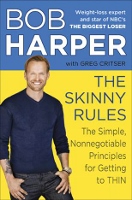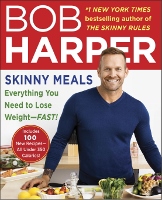
 The Skinny Rules (2012) is a weight loss diet
The Skinny Rules (2012) is a weight loss diet
- Avoid processed foods (including sugars, fruit juices, refined flours and grains), fatty foods, and chemicals
- Eat no animal-foods one day a week
- Eat vegetables, proteins especially fish, high-fiber foods including whole grains, apples and berries, and monounsaturated oils
- One splurge meal a week.
Below is a description of the food recommendations in the diet. What to eat | Foods to avoid. There’s a lot more in the book.
Use this page as a cheat sheet alongside the book. Send this page to friends, family, and anyone else who you want to understand what you’re eating on this diet.
Get a copy of The Skinny Rules for exercise tips and workout plans, details of the role of hormones, supplementation plan, meal plans, tips for meal planning, and recipes.
Get a copy of Skinny Meals for recipes.
Also see the Chewfo write-up for Bob’s follow-up book, Jumpstart to Skinny.
The reasoning behind The Skinny Rules
Bob Harper produced a set of rules to make it easy for people to choose their foods without getting “Clutter Brain” – what happens when you hear so much information about a subject that you can’t make solid, reasonable decisions – for dieters this can lead to anxiety, exhaustion, depression, and bingeing. He mentions some studies that he uses to justify the rules, but doesn’t go into a lot of detail.
The Skinny Rules diet plan – food list
Foods to eat with The Skinny Rules
- Prefer organic, locally grown food. Foods most worth buying organic include: apples, asparagus, celery, cherries, lettuce, nectarines, peaches, pears, spinach, strawberries, sweet bell peppers, and tomatoes.
- Protein – at every meal. Take your weight in pounds and divide it by two- that’s how much protein you should be eating in grams every day
- Fish is best. Fatty fish may help you lose the most weight
- Eggs – egg whites are good for protein; get omega-3 eggs if you can
- Chicken and turkey – prefer organic and humanely raised
- Pork in moderation – preferably only if humanely raised
- Beef in moderation – go organic and grass fed, stick with the leanest cuts, cooked simply without sauce (except at your splurge meal). Note that a serving size of lean steak is a lot smaller than other forms of protein. And note that turkey is a better go-to protein if you’re serious about weight loss
- Cheese – full fat is okay in moderation
- Tofu and tempeh
- Foods with a lot of fiber (eat 30-50 grams of fiber a day)
- Soluble fiber – fruits, vegetables, beans, nuts, oat bran, barley, flax
- Insoluble fiber – wheat bran, rice bran, corn bran, skins of fruits and vegetables, nuts, seeds, and whole-grain foods
- Whole grains, including whole grain bread (with “whole grain wheat flour” as the first ingredient, whole wheat pasta (the only ingredients should be whole-wheat flour and water, serving size 2oz, Ezekiel bread
- Farro, barley, quinoa
- Eat a lot of vegetables
- Raw vegetables, leafy vegetables, vegetable purees
- Favorites include kale and broccoli
- Eat as much as you want of these veggies, any time: artichoke, arugula, asparagus, bell peppers, bok choy, broccoli, broccoli rabe, Brussels sprouts, cabbage, cauliflower, chard, Chinese cabbage, collard greens, cucumber, daikon, eggplant, fennel, garden cress, green beans, jicama, kale, kohlrabi, komatsuna (Japanese mustard spinach), leeks, lettuces, mizuna, mushrooms, mustard greens, onions, radishes, spinach, tomatoes, yellow summer squash, watercress, zucchini
- Limit starchy vegetables – no more than half a cup, and always before 2pm: beets, carrots, parsnips, pumpkin, rutabaga, sweet potatoes / yams, turnips, winter squash / butternut squash
- Limit avocadoes to one quarter of an avocado a day
- Apples and berries (strawberries, blueberries, raspberries, blackberries, etc.) – eat them every day. Eating fruit (not fruit juice) at the beginning of a meal can reduce energy intake
- Fats – 25-35% of your daily calories should be from fat
- Look for monounsaturated fats made from plants – olive oil, canola oil. Limit the amount you use.
- Coffee – up to 2 cups, before noon, without fatty milk products. Avoid coffee, tea, and other stimulants after 3pm so you can sleep well. You can have a small amount of fat-free or 2% milk or soy milk with your coffee
- Eat a “real” breakfast – may include oatmeal, eggs, greek yogurt
- Plan a splurge meal (“cheat day”) once a week
- You don’t get a splurge meal until you’ve completed the first two weeks of the rules
- It’s one meal – breakfast, lunch, or dinner – a week. Not a whole day of splurges
- Write down the calorie count before you eat
- No liquid calories except red wine. Drink a large glass of water before the meal.
- Decide whether you want to eat rich or eat big. Do you want truly forbidden foods (though no fast-food joints), bigger portions, or some mix?
- Breakfast and lunch are the best times for splurge meals. If you must splurge for dinner, make sure it’s before seven.
- At a restaurant, tell them to hold the bread
- Don’t splurge by yourself
Learn to read food labels so you know what you’re eating. Be aware of serving sizes. Control your portions. Get and use a good reference book that lists the calories, fiber, fat, and carbs of all common foods – a good one is The CalorieKing Calorie, Fat, and Carbohydrate Counter by Allan Borushek.
Make your own food and eat at least ten meals a week at home.
Foods to avoid or limit with The Skinny Rules
- Drinks with calories
- Soft drinks – including diet soft drinks
- Juices and juice drinks (eat fruit instead)
- Cream, half and half, or whole milk in your coffee. No lattes, chais, frappes, or mochas. Small amounts of 2% no-fat milk are okay, as is soy milk
- Alcohol – until you get to your goal weight, when red wine is acceptable. Avoid alcohol after 8.
- Sugars – including sugar, honey, juices, high fructose corn syrup HFCS, etc.
- Refined flour and grains
- Breads that don’t have “whole grain wheat flour” as the first ingredient (“wheat flour” does not mean whole wheat), and/or have a sweetener of any kind in the first 5 ingredients
- Pastas that don’t contain only whole-wheat flour and water (pasta serving size is 2 ounces)
- White rice – and also brown rice, which has little more fiber than white rice and limited protein. Start limiting yourself to ½ cup at a time and wean yourself off it
- Potatoes (other tubers, including sweet potatoes, parsnips, turnips, and many lesser-known kinds of potatoes are acceptable)
- Fatty foods
- Limit egg yolks – have egg whites by preference
- Foods where the percentage of fat calories per serving is over 20%
- Saturated fat
- Trans fats
- Fried foods
- Processed foods
- Fast foods
- Salt – limit to less than 2,000 milligrams a day
- Chemicals
- Artificial sweeteners including aspartame
- Food dyes
- Polysorbate 60
- Olestra
- Monosodium glutamate MSG
- No carbs after lunch
- Eat no or very low carbs after lunch, and those only if offset by even more fiber
- Snack on fiber, protein, vegetables, and fresh fruits (not dried fruits)
- Eat lean and green at night
- One day a week, eat no animal protein – meat, poultry, fish/seafood, eggs, milk products. Eat beans, nuts, and seeds.
- Don’t go to bed stuffed – ways to do this include: don’t eat three hours before going to bed; don’t eat after eight; don’t eat anything after dinner
Health benefits claimed in The Skinny Rules
This diet claims to help people to lose weight. Also to reduce related chronic health conditions including acne, anal leakage, high bad cholesterol and low good cholesterol, chronic diarrhea, type 2 diabetes, gallstones, GERD/acid reflux, gluten allergies, halitosis, heart disease, irritable bowel syndrome IBS, skin rashes
Consult your doctor before starting a new diet. This page describes what the authors of the diet recommend – Chewfo is describing the diet only, and does not endorse it.
For more information on nutrition studies, non-food recommendations, and recipes in The Skinny Rules diet, see The Skinny Rules.
![]() Diet book
Diet book
Get a copy of Skinny Meals for recipes.
![]() Recipe book
Recipe book
How has this diet helped you? Please add a comment below.

{ 0 comments… add one }